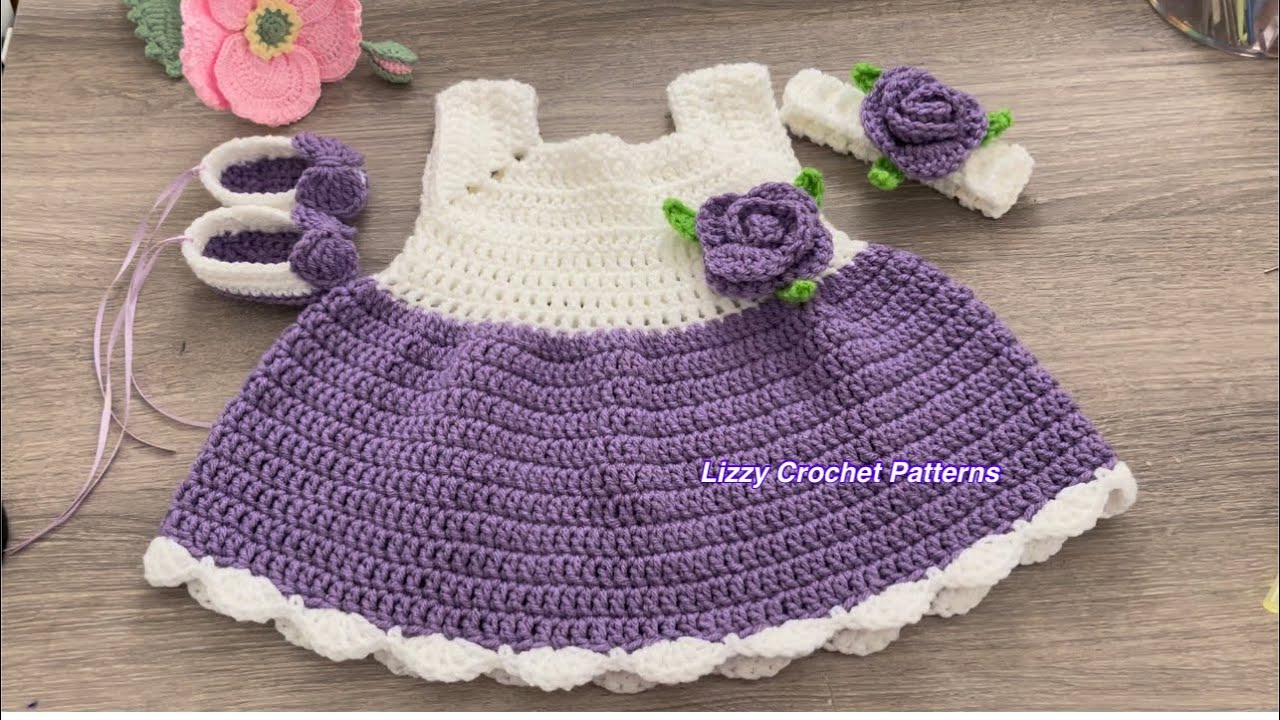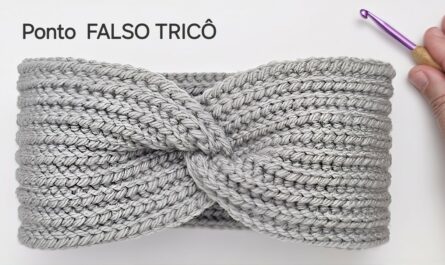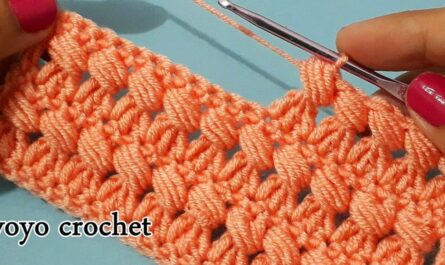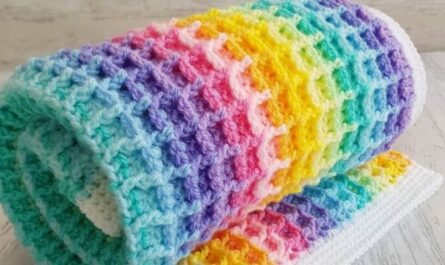There’s an unparalleled sweetness in handmade baby clothes, especially a coordinated set crafted with delicate stitches and softest yarns. For newborns and babies up to three months, a “pretty” crocheted dress, booties, and headband set offers ultimate charm, comfort, and a truly unique touch. Imagine gentle hues, subtle lace details, and a cozy fit – creating an ensemble perfect for those first precious photos, a coming-home outfit, or a treasured gift.
This detailed guide will lead you through crocheting a complete, adorable, and customizable baby outfit, ensuring each piece is as lovely as it is comfortable for the tiniest of tots.
Why Crochet a Coordinated Baby Set (0-3 Months)?
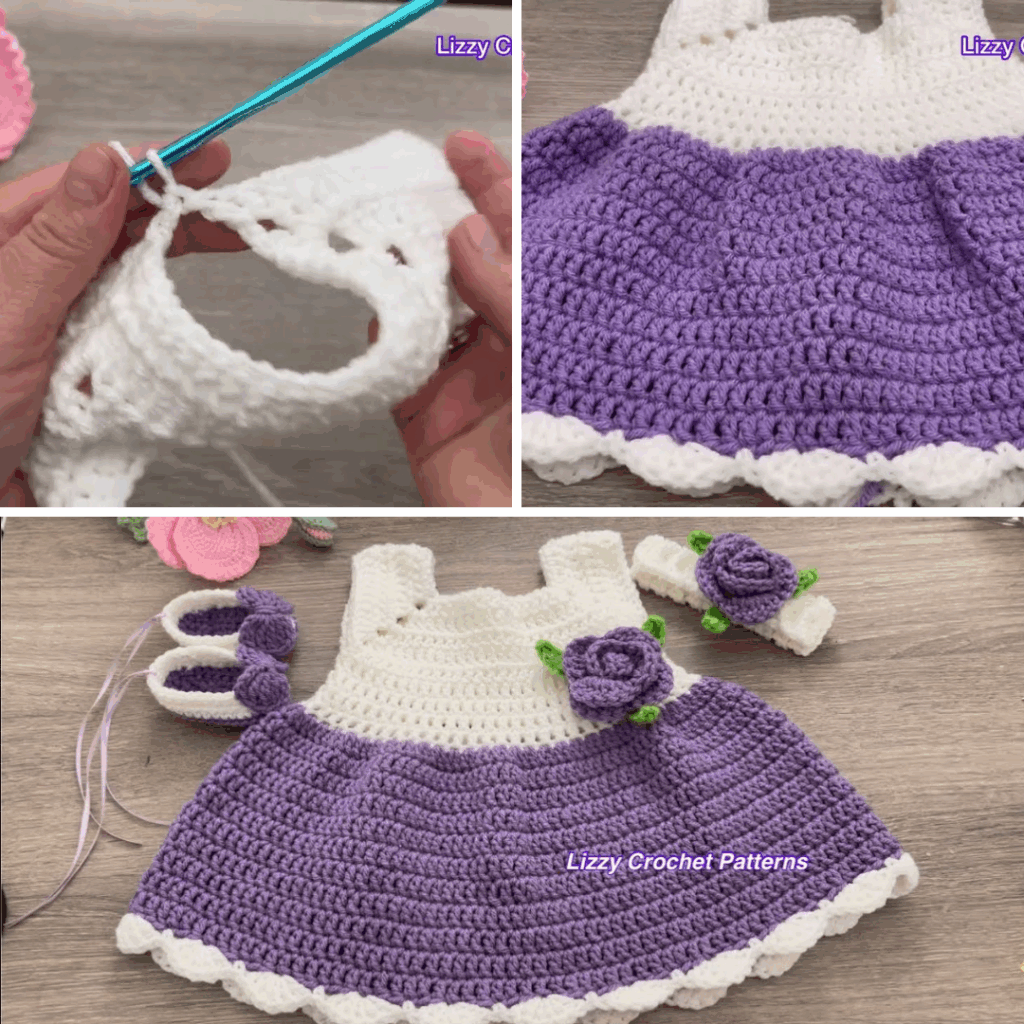
- Perfect for Gifting: A handmade set is the ultimate baby shower gift, often becoming an immediate favorite for its uniqueness and thoughtfulness.
- Personalized & Cherished: You control every detail, from fiber to color, making it a one-of-a-kind garment that often becomes an heirloom.
- Ultimate Comfort & Safety: You select the softest, most hypoallergenic yarns, ensuring no irritating tags or harsh seams against delicate newborn skin.
- Instant Outfit: Provides a complete, ready-to-wear ensemble, perfect for quick changes or special occasions.
- Skill Building: A small project allows you to practice various crochet techniques—garment construction, working small accessories, and creating matching motifs.
- Relatively Quick to Make: Due to the tiny size, this set works up much faster than larger projects, offering satisfying results in a shorter time frame.
Key Elements of a “Pretty” Set (0-3 Months):
Cohesion and delicate details are key to a beautiful matching set:
- The Dress:
- Bodice/Yoke: Usually top-down, simple, and comfortable, allowing for easy dressing.
- Skirt: Gently flared, ensuring comfort and easy movement for tiny legs, not too long to avoid tangling.
- Sleeves: Sleeveless, cap sleeves, or short puff sleeves are most common and practical for newborns.
- Neckline: Soft, stretchy, and wide enough for easy dressing over a baby’s head.
- Closure: Buttons down the back are essential for convenience.
- “Pretty” Details: Delicate lace edgings (shells, picots), subtle ruffles, or soft texture stitches (like puff stitches).
- The Booties:
- Designed to be soft, warm, and, crucially, stay on tiny feet.
- Features matching “pretty” details to the dress, like a ruffled cuff or a small bow.
- The Headband:
- Soft, stretchy, and comfortable – absolutely no tight elastic.
- Often adorned with a matching crocheted motif (flower, bow) for an extra cute touch.
- Overall Cohesion: A consistent yarn choice, color palette, and repetition of decorative elements across all three pieces tie the set together beautifully.
Choosing Your Tools & Materials:
Selecting the right supplies is paramount for creating a soft, safe, and beautiful baby set.
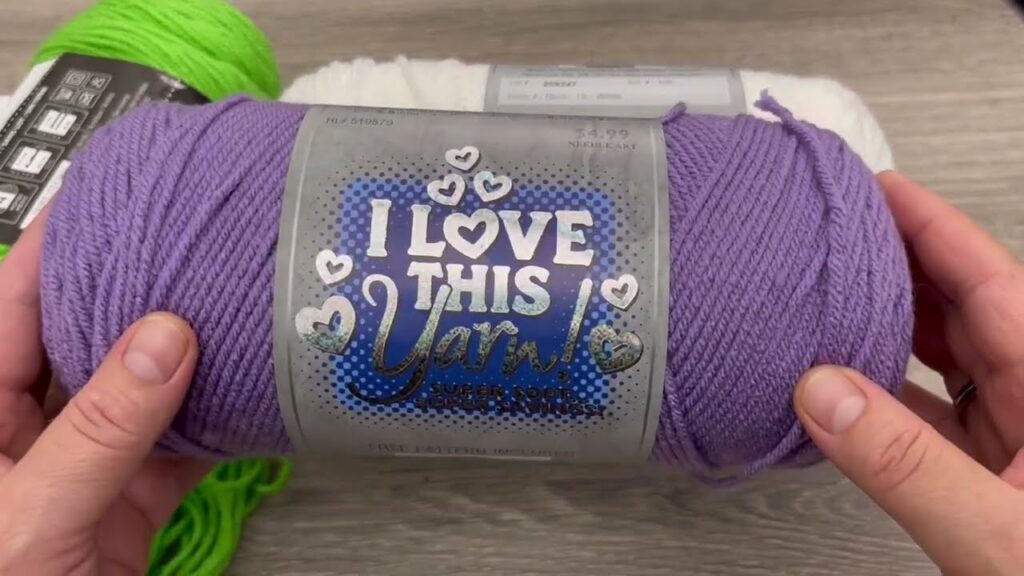
- Yarn (ABSOLUTELY CRUCIAL for 0-3 Months!):
- Fiber:
- 100% Cotton: Highly recommended for its breathability, absorbency, softness, and excellent stitch definition. Ideal for warmer climates.
- Superwash Merino Wool: Incredibly soft, provides warmth without bulk, and is conveniently machine washable (check label). A luxurious choice.
- Baby-Specific Acrylic: Many modern acrylic yarns are wonderfully soft, durable, hypoallergenic, and very easy to care for (often machine wash and dry). An excellent, affordable option.
- Weight: Sport Weight (often labeled “baby weight”) or DK (Double Knitting) yarns are ideal. They create a delicate, lightweight fabric that is comfortable and not too bulky for a newborn.
- Color Palette: For a “pretty” set, opt for classic baby pastels (baby pink, blue, yellow, mint green, lavender), timeless neutrals (white, cream, ivory, pale grey), or very gentle variegated yarns. Consider a single main color with a small amount of a complementary accent color for details.
- Quantity: For the entire 0-3 month set (dress, booties, headband), you’ll typically need between 200-300 yards (approx. 180-270 meters), depending on the specific design and amount of ruffles.
- Fiber:
- Crochet Hook:
- Consult your chosen yarn label for a suggested hook size (e.g., 3.0mm, 3.5mm, 3.75mm, 4.0mm).
- Crucial for Baby Wear: The correct hook size for your gauge is more important than the label’s suggestion. You will likely need to adjust your hook size (up or down by half a size) to achieve the exact gauge specified in your chosen pattern for a perfect fit.
- Other Notions:
- Stitch Markers: Essential for marking the beginning of rounds, raglan lines, or increase/decrease points.
- Tapestry Needle: For neatly weaving in all yarn ends.
- Scissors.
- Small, Flat Buttons: 3-5 tiny, flat buttons (approx. 0.4-0.5 inch / 1-1.25 cm diameter) for the dress back closure. Choose ones that are easy to fasten and lie flat for comfort.
- Thin Ribbon (Optional): For decorative bows on the dress, booties, or headband.
- Optional Small Embellishments: A few small pearl beads (securely sewn onto the dress/headband) or tiny pre-made fabric flowers. Ensure all embellishments are absolutely secure and not a choking hazard.
Understanding Sizing & Gauge (Extremely Important for Newborns!)
For garments as small as 0-3 months, precise sizing is absolutely critical for comfort and appearance. A slight difference in gauge can make a significant difference in fit.
Approximate Baby Measurements (0-3 Months for reference):
- Chest Circumference: 16-18 inches (40.5-45.5 cm)
- Finished Dress Length (Shoulder to Hem): 12-14 inches (30.5-35.5 cm)
- Bootie Sole Length: Approx. 3.5-3.75 inches (9-9.5 cm)
- Head Circumference (Headband): 14-16 inches (35.5-40.5 cm)
Disclaimer: These are general averages. Always refer to a specific, detailed crochet pattern for precise stitch counts and measurements for the 0-3 month size.
How to Make a Gauge Swatch (Do NOT Skip This Step!):
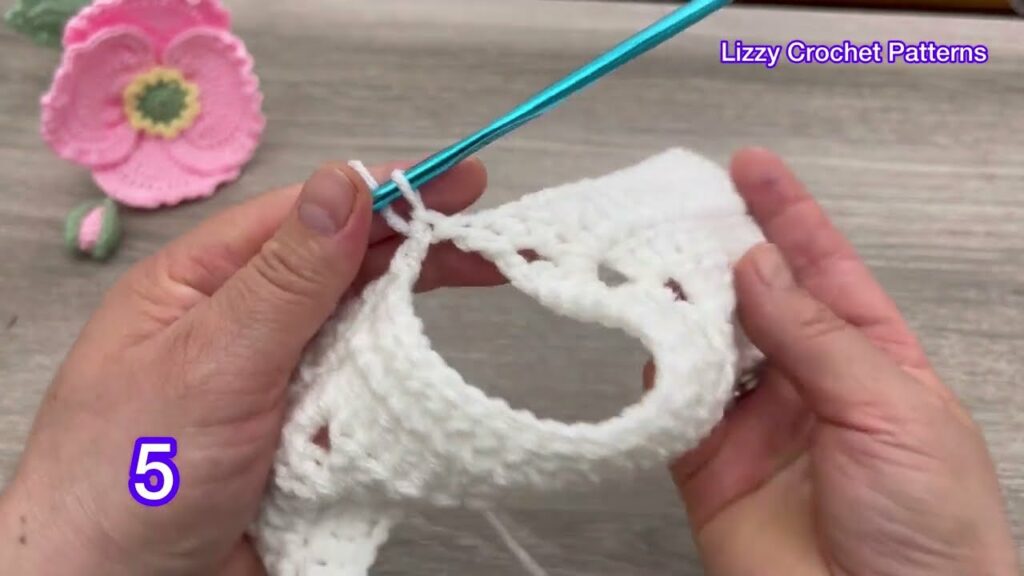
- Chain: Chain about 20-25 stitches, plus any turning chains (e.g., ch 3 for dc) as per your chosen main stitch.
- Work: Crochet a square of at least 6×6 inches (15×15 cm) in the main stitch pattern you’ll be using for the dress (e.g., double crochet). A larger swatch provides a more accurate measurement.
- Wash & Block: Fasten off your swatch. Crucially, wash and block your swatch exactly as you plan to treat the finished set. This step relaxes the fibers and reveals the true stitch size and drape after washing, which can change significantly.
- Measure: Once dry, lay the swatch flat. Place a ruler over the center. Count how many stitches fit within 4 inches (10 cm) and how many rows fit within 4 inches (10 cm).
- Adjust:
- If you have more stitches per inch than your pattern (or desired gauge) states (your work is too tight), go up half a hook size and re-swatch.
- If you have fewer stitches per inch than your pattern states (your work is too loose), go down half a hook size and re-swatch.
- Repeat until your gauge precisely matches the pattern’s recommendation.
General Stitch Patterns for a “Pretty” Set:
- Main Body (Dress/Booties/Headband):
- Double Crochet (dc): Works up quickly, creates a soft, draped fabric.
- Half Double Crochet (hdc): Slightly denser than dc, good for structure.
- “Pretty” Accent Stitches (for ruffles, edgings, cuffs):
- Shell Stitch/Fan Stitch: (e.g., 5 dc in one st, skip 2, sl st) Creates beautiful scalloped or fan-like edges, perfect for ruffles on dress hems, sleeve cuffs, bootie tops, or headband edges.
- Picot Stitch: (ch 3, sl st into 1st ch) Creates delicate, tiny points for a dainty edge.
- V-Stitch: (dc, ch 1, dc in same st/sp) Creates a simple, delicate openwork pattern for the skirt or a headband.
- Puff Stitch/Bobble Stitch: Can be strategically placed for subtle texture and cuteness.
- Ribbing (Booties/Headband):
- Front Post/Back Post Double Crochet (fpdc/bpdc): Creates a defined ribbed texture.
- Single Crochet in Back Loop Only (sc blo): Creates a simple, stretchy ribbing.
Step-by-Step Construction: The Coordinated Set (0-3 Months)
This outline provides the general methodology for creating a top-down dress with matching accessories. For precise stitch counts, specific increase/decrease rates, and unique design details, you will need to consult a specific, detailed crochet pattern that matches your desired size and aesthetic for the 0-3 month range.
Part 1: The Pretty Baby Dress (Top-Down Construction)

- Phase 1: The Yoke (Top-Down & Shaping)
- Starting Chain: Begin with a chain suitable for the neckline circumference (as per pattern).
- Neckband: Work 2-3 rows of sc or hdc. Create small, evenly spaced buttonholes on one back placket edge (e.g., ch 2, skip 2 stitches, then work into the ch-2 space on the next row).
- Yoke Shaping (Raglan or Round): Follow your pattern to increase stitches at specific points in subsequent rows (e.g., 4 raglan corners for a raglan yoke, or evenly around for a round yoke) until the yoke measures the correct depth from neckline to underarm for 0-3 months.
- Phase 2: Separating for Bodice & Sleeves
- Work across the main body stitches (front and back panels), then chain for the underarm space (e.g., 2-4 chains).
- Skip the sleeve stitches (place them on a holder if adding sleeves later). Repeat for the second sleeve.
- This creates the armholes.
- Phase 3: The Bodice & Skirt Transition
- Join in the Round: Sl st to join the ends of the last row (front and back panels), forming a complete circle. You will now work in continuous rounds or join with a sl st at the end of each round.
- Bodice Length: Work a few straight rounds of your main stitch (e.g., dc) to form the short bodice below the underarms.
- Skirt Start (Initial Flare): In the next round, significantly increase stitches to create the initial fullness of the skirt (e.g., work 2 dc in every 2nd or 3rd stitch around).
- Phase 4: The Skirt
- Continue working in rounds in your chosen skirt stitch (e.g., dc, V-stitch).
- Gradual Increases: Continue to gradually increase stitches evenly in subsequent rounds (e.g., every 3-5 rounds) to achieve a gentle A-line flare and fullness suitable for a baby.
- Length: Work until the skirt reaches the desired dress length for 0-3 months (approx. 12-14 inches from shoulder to hem).
- “Pretty” Hem Edging: Finish with a beautiful, delicate edge like a Shell Stitch scallop or a Picot edging.
- Phase 5: Sleeves (Optional)
- If adding sleeves: Attach yarn to an armhole opening. Pick up stitches evenly around.
- Cap Sleeve: Work just a few rounds of your main stitch.
- Puff Sleeve: Increase stitches significantly in the first 1-2 rounds to create fullness, then work a few more rounds, possibly with some decreases for shaping.
- Finish the sleeve with a matching “pretty” edging (shell stitch, picot, or a simple sc cuff). Fasten off. Repeat for the second sleeve.
Part 2: The Pretty Baby Booties (Make 2)
Most booties start with an oval sole and work upwards.
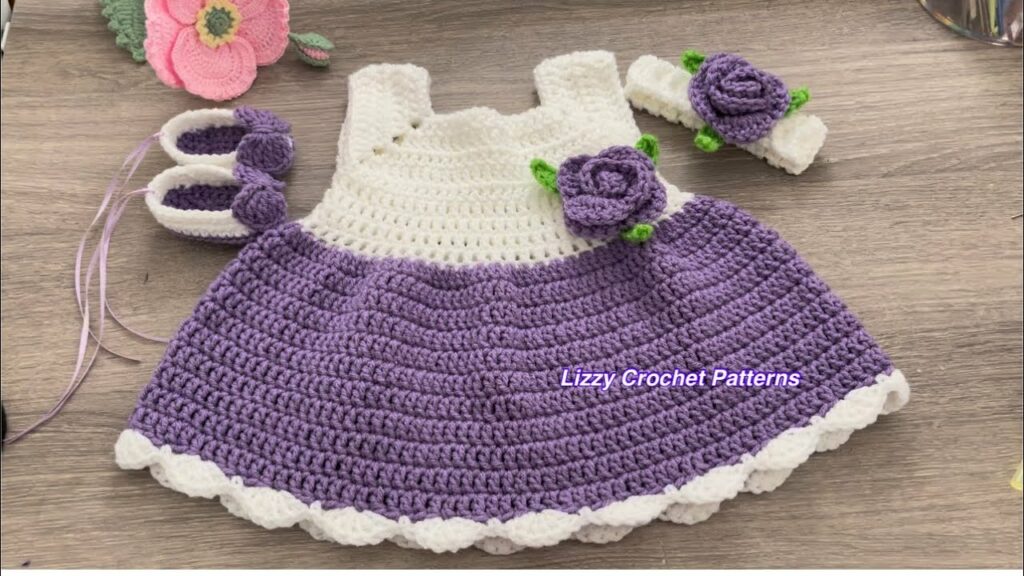
- Phase 1: The Sole
- Starting Chain: Chain the length specified by your pattern for the sole (e.g., 8-10 chains).
- Work sc or hdc around the chain, increasing at the ends to form an oval shape. Work 2-3 rounds to build up the sole to the correct 0-3 month size (approx. 3.5-3.75 inches long).
- Phase 2: The Sides
- Work 1-2 rounds in the BLO (Back Loop Only) to create a neat, firm edge for the sole, making the sides stand up.
- Work straight rounds of sc or hdc for the height of the bootie sides.
- Phase 3: Toe Shaping
- Start decreasing stitches at the front of the bootie (usually the rounded end) over several rounds to shape the toe area.
- Phase 4: Ankle & Cuff
- Work a few straight rounds for the ankle height.
- “Pretty” Cuff: Finish with a matching Shell Stitch or Picot edging, or a delicate ribbed cuff (e.g., using sc blo).
- Finishing: Fasten off. Weave in all ends securely. Repeat for the second bootie.
Part 3: The Pretty Baby Headband
- Phase 1: The Band
- Starting Chain: Chain a length slightly less than the head circumference (approx. 13-15 inches for 0-3 months), allowing for stretch. Sl st to join, being careful not to twist.
- Work rounds of sc, hdc, or sc blo (for subtle ribbing) until the desired width (e.g., 1-1.5 inches).
- Phase 2: The Embellishment
- Matching Motif: Crochet a small flower, a tiny bow, or a simple leaf motif that complements the dress’s details.
- Simple Crochet Flower Example: Create a Magic Ring. Ch 2 (counts as 1st dc). Work 5 dc into MR, sl st into MR. Ch 2. Repeat 4 more times for 5 petals. Fasten off, pull MR tight.
- Attach Motif: Securely sew the crocheted motif (or ribbon bow/other embellishment) to the front center of the headband.
- Matching Motif: Crochet a small flower, a tiny bow, or a simple leaf motif that complements the dress’s details.
- Finishing: Fasten off. Weave in all ends securely.
Overall Finishing for the Set:
- Weave in All Ends: Use your tapestry needle to meticulously weave in every single yarn tail on all three pieces. This is crucial for a professional, comfortable, and safe finish.
- Blocking (THE Magical Transformation!):
- Gently hand wash all three finished pieces (or machine wash if your yarn allows, using a delicate cycle and a mesh laundry bag) in cool water with a mild, gentle soap suitable for baby items.
- Gently squeeze out excess water (do not wring or twist).
- Lay all pieces flat on clean towels or blocking mats. Gently shape each piece to its correct dimensions, smoothing out any unevenness and opening up any lace or shell patterns. Use rust-proof pins to hold shapes if needed.
- Allow the entire set to air dry completely. Blocking is essential for setting the stitches, evening out tension, enhancing drape, softness, and giving your set a beautifully finished, professional quality.
- Attach Buttons: Sew the tiny, flat buttons securely onto the back of the dress, aligning them with the buttonholes.
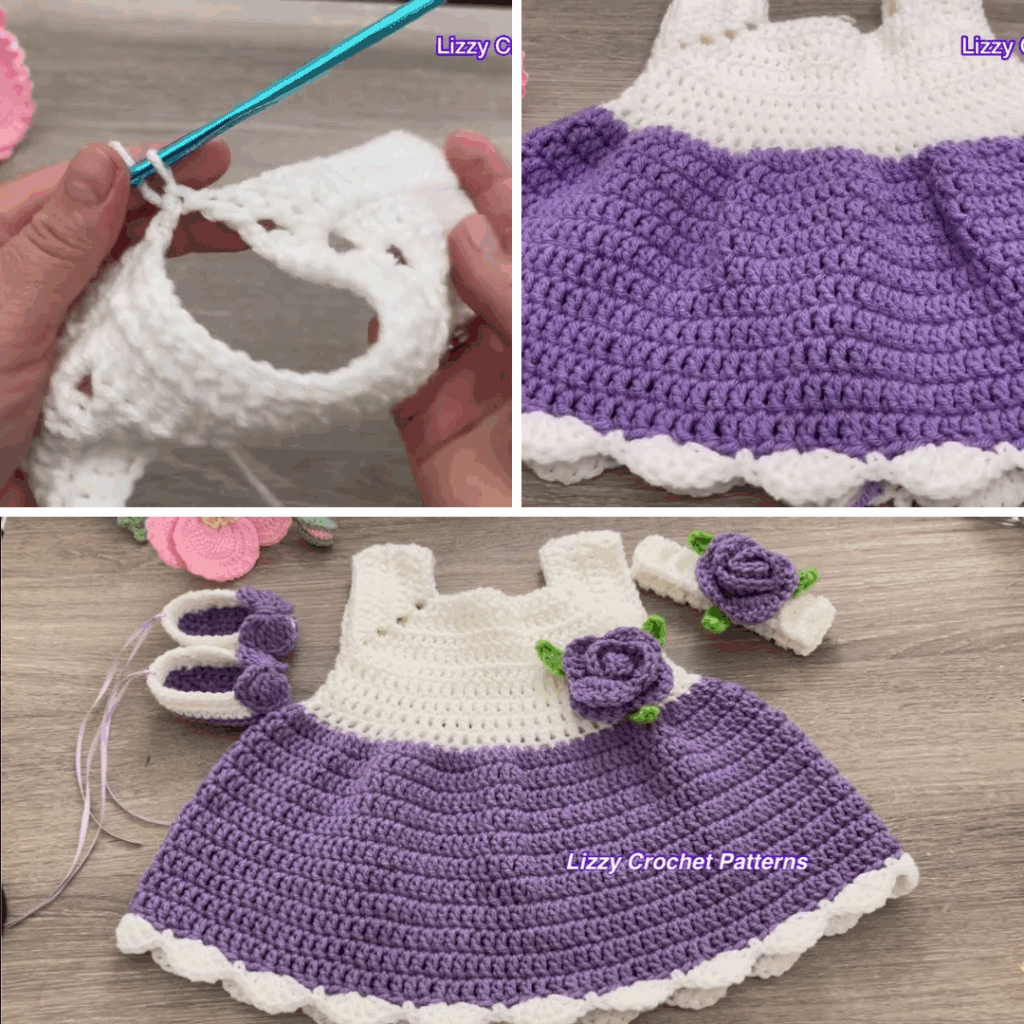
Tips for “Pretty” Set Success (0-3 Months):
- Yarn Quality is Paramount: Always prioritize the softest, most breathable, and easily washable yarns. Newborn skin is very delicate.
- Gauge Consistency: It’s the only way to ensure the dress, booties, and headband fit correctly and match each other perfectly.
- Seamless Construction: When possible, opt for top-down seamless methods for the dress and working booties in the round to minimize bulky seams that could irritate a baby’s delicate skin.
- Tiny, Flat Buttons: Choose buttons that are easy to close and lie flat for baby’s comfort when lying down.
- Safety First: Avoid any small, detachable embellishments (like beads, tiny charms, or loosely tied ribbons) that could pose a choking hazard. Securely stitch down all bows and decorative elements.
- Delicate Embellishment: Keep added details proportionate to the tiny size of the garments. Less is often more for “pretty” and safe baby wear.
Care Instructions for Your Handmade Baby Set:
- Always follow your yarn label’s care instructions: Some yarns require hand washing, while others are machine washable on a gentle cycle.
- Reshape and Lay Flat to Dry: Gently reshape all three pieces while wet and lay them flat on a clean towel or drying rack to air dry completely. Do not hang, as this can stretch the fabric and distort the shapes.
VIDEO TUTORIAL ;
Creating a crocheted baby dress, booties, and headband set is a deeply rewarding experience. Each tiny stitch carries your care and affection, resulting in a truly precious, unique, and adorable ensemble that will be cherished by parents and baby alike. Happy crocheting! Sources
